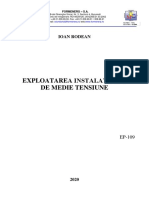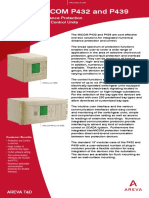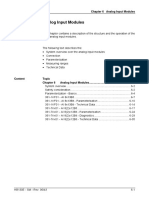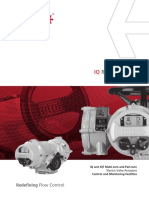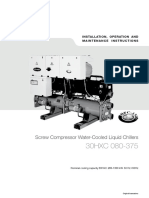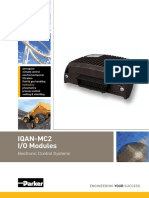Process Control Systems
Uploaded by
Hammad AnsariProcess Control Systems
Uploaded by
Hammad AnsariReview of Last class class..
Industrial Electronics (3+0)
Week-02 23rd Sep 2012
Industrial Electronics Intro Course Intro Introduction to Process Control Systems Types of processes
Continous Batch Individual process Individual control Centralized control Distributed control
2
Process control configurations
Process Control Systems
Week-01
Instructor: Engr. Shiraz Latif
11
Structure of process control systems Introduction to PLC & Ladder logic
Open-loop v/s closed-loop systems
Open-loop p p control system y
Process is controlled by inputting to the controller the desired set point (command signal or reference f signal) i l) Accepting whatever the final results Only input is the desired set level hence blind control No information regarding current status Inexpensive and less complex Less accurate Poor process control
Open loop speed control Of DC motor
Closed-loop p control system y
Components p of closed-loop p control
Output of a process affects the input Current output is measured and compared to the desired output
Set point
Error signal = desired output actual output
Continuous adjustments until error becomes zero (ideally)
Input that determines the desired operating point for the process th Usually provided by the operator, or may be provided by some system Variable that is being measured and controlled Contains information about the process current status Feedback signal Ideally matches the set pint Ideally,
6
Process variable
. Components p
Error Amplifier
Container Filling Closed-loop process control
Determines whether the process operation matches th set the t point i t Differential amplifier Magnitude and polarity of error signaldetermines how the process be brought back under control Produces corrective output signal based on error signal Component C t that th t di directly tl affects ff t a process change h Eg. Motors, heaters, fans, solenoids
Controller
Output actuator
Container filling g process p control explanation.. p
Regulators:
How the process works?
Identify y inputs p and outputs.. p Identify
Set p point ? Process variable? Error amplifier? Controller? Output actuator?
9
A closed-loop system that maintains a steady level or value of some quantity Used in industrial processes to provide precise regulation p g of some parameter p like voltage, speed, current, tension, position, temperature
10
Process Control variables
Loop regulator L l t for f tension control of textile machines. Regulating prob: to synchronize the one side of loop to the other side side, to maintain the constant loop. How it works?
Process control systems applies to large section of industries Usually involves the manipulation of a variety of process variables in order to achieve automatic control. Number of variables depends p on the product p that is being g manufactured. Some of the variables can be
Pressure Temperature Flow Level Conductivity Weight
Variation in one variable can cause affect on other as well well.
12
11
Industrial Process Controllers
1 Two position control 1.
Industrial Process Control Modes; ;
Two Position Controller Proportional Controller Integral Controller Differential Controller PI Controller PD Controller PID Controller PID-Controller
oldest strategy gy for control use of a switch ON/Off control discontinuous form of control action also known as two position controller. primitive, cheap and effective method of control if a fairly f i l large l fluctuation fl t ti of f the th process variable i bl is i acceptable. A perfect ON/Off controller is
Purpose of control is to hold the measured variable output from a process within set limits
ON when the measurement is below the setpoint and the manipulated variable is at its maximum value, OFF when measurement is above the setpoint and the MV is a minimum.
14
13
Room heating system with on/off control
(74oF = 24oC) ( )
On/off controllers usually have inertia that introduces
What is control var? Set point ? What does the waveforms explain?
Overswings Delays or lag times before the variable attains the reference level again.
Why ?
15
16
2 Differential action 2.
Differential or delayed y ON/OFF action Simple ON/OFF action with additional hysteresis or a dead-band built in. set reference 75, switching points are delayed by 3 3F F. OFF @ 78F On @ 72 72F F hysteresis of 6F. There is, of course, still some inertia.
Hence, the room temperature will go from about 70F to about 80F.
17
You might also like
- Micom P432 and P439: Distance Protection and Control UnitsNo ratings yetMicom P432 and P439: Distance Protection and Control Units8 pages
- Modicon-TM3 Analog IO Modules Hardware GuideNo ratings yetModicon-TM3 Analog IO Modules Hardware Guide118 pages
- Modbus RTU Slave Interface: X-Gateway Interface Addendum100% (1)Modbus RTU Slave Interface: X-Gateway Interface Addendum15 pages
- Tuning of PID Controller: What Is A PID Control?No ratings yetTuning of PID Controller: What Is A PID Control?4 pages
- Eaton Y7 197211 EASY E4 UC 12RC1 en - GBNo ratings yetEaton Y7 197211 EASY E4 UC 12RC1 en - GB8 pages
- Catalog Inverter Huawei SUN2000-100KTL-M1No ratings yetCatalog Inverter Huawei SUN2000-100KTL-M12 pages
- Instruction Manual: Smart Valve PositionerNo ratings yetInstruction Manual: Smart Valve Positioner52 pages
- Materi Training Desicant Dryer - BEKO TECHNo ratings yetMateri Training Desicant Dryer - BEKO TECH19 pages
- Adaptive Program For PVS800 Central Inverters: Application GuideNo ratings yetAdaptive Program For PVS800 Central Inverters: Application Guide52 pages
- Vortex Flow Meter Catalog Dalian Zero Instrument Technology Co., LTD ChinaNo ratings yetVortex Flow Meter Catalog Dalian Zero Instrument Technology Co., LTD China21 pages
- FLT93 Installation, Operation and Troubleshooting GuideNo ratings yetFLT93 Installation, Operation and Troubleshooting Guide12 pages
- Electrical Actuators: Motors Are GenerallyNo ratings yetElectrical Actuators: Motors Are Generally5 pages
- Installation Operation Manual 30HXC - 080 - 375 PDFNo ratings yetInstallation Operation Manual 30HXC - 080 - 375 PDF50 pages
- Differences Between Indoor and Outdoor Sub StationNo ratings yetDifferences Between Indoor and Outdoor Sub Station5 pages
- Strip Guiding Systems Sensors: Automation GMBHNo ratings yetStrip Guiding Systems Sensors: Automation GMBH11 pages
- Process Controller Maxxis 5 PR 5900: Installation ManualNo ratings yetProcess Controller Maxxis 5 PR 5900: Installation Manual136 pages
- Greater Karachi Regional Plan - 2047 (CRC Decision)No ratings yetGreater Karachi Regional Plan - 2047 (CRC Decision)4 pages
- Internship Weekly Report: Third Week, 11th July 2011 To 16th July 2011No ratings yetInternship Weekly Report: Third Week, 11th July 2011 To 16th July 20115 pages
- Identification of Energy Theft and Tampered Meters Using A Central Observer Meter: A Mathematical ApproachNo ratings yetIdentification of Energy Theft and Tampered Meters Using A Central Observer Meter: A Mathematical Approach6 pages
- 65 NM CMOS Devices For Low Power ApplicationsNo ratings yet65 NM CMOS Devices For Low Power Applications1 page
- 15.quality Control System For Paper Machines (Read-Only) (Compatibility Mode)No ratings yet15.quality Control System For Paper Machines (Read-Only) (Compatibility Mode)19 pages
- automatic-control-for-mechanical-engineers-pdfNo ratings yetautomatic-control-for-mechanical-engineers-pdf176 pages
- An Introduction To Nonlinear Model Predictive ControlNo ratings yetAn Introduction To Nonlinear Model Predictive Control23 pages
- A First Course in Fuzzy and Neural Control - 2003 - Hung T. Nguyen Et AlNo ratings yetA First Course in Fuzzy and Neural Control - 2003 - Hung T. Nguyen Et Al305 pages
- Drive System Application: Closed-Loop Torque Control and Load DistributionNo ratings yetDrive System Application: Closed-Loop Torque Control and Load Distribution26 pages
- Ic6501 Control Systems: UNIT-1 (2 Mark Q/A)No ratings yetIc6501 Control Systems: UNIT-1 (2 Mark Q/A)6 pages
- ARCODE Error Codes and Possible Solutions - V2.0 - enNo ratings yetARCODE Error Codes and Possible Solutions - V2.0 - en37 pages
- P I C D A A U S I 8 2 4 A D: Erformance Mprovements IN Lass Udio Mplifiers Sing X Udio RiversNo ratings yetP I C D A A U S I 8 2 4 A D: Erformance Mprovements IN Lass Udio Mplifiers Sing X Udio Rivers12 pages
- Advanced Control Loops: So Called "Conventional" FeedbackNo ratings yetAdvanced Control Loops: So Called "Conventional" Feedback19 pages
- 16-Paper - Lateral Control of Front-Wheel-Steering PDFNo ratings yet16-Paper - Lateral Control of Front-Wheel-Steering PDF46 pages
- The Relative Gain For Non-Square Multivariable Systems - Chang1990 PDFNo ratings yetThe Relative Gain For Non-Square Multivariable Systems - Chang1990 PDF15 pages



